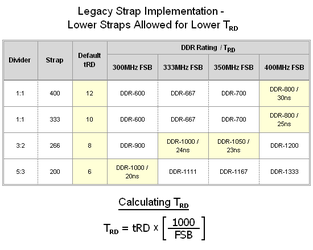Gigabyte GA-EP45-DS3P/E5200 - determine best performance point: FSB vs. Voltage help
Hi!
First of all I hope I posted this thread in the right place and maybe I can get a response from some experts regarding this issue below.
and maybe I can get a response from some experts regarding this issue below. 
I ve tried to give you all necessary information, if it is missing something please let me know.
First of all I am familiar with following articles, guides (FSB-tRD-CPU speed-MCH straps-CAS relations):
1.)http://www.thetechrepository.com/showthread.php?t=30
2.)http://www.thetechrepository.com/showthread.php?t=160
3.)http://www.thetechrepository.com/showthread.php?t=195
4.)http://www.anandtech.com/mb/showdoc.aspx?i=3208&p=1
5.)http://www.xbitlabs.com/articles/memory/display/core2duo-memory-guide.html
6.)http://www.anandtech.com/cpuchipsets/intel/showdoc.aspx?i=3251&p=6
These above (especially 1-4.) were a huge help. Thanks. I think I understand the basic rules, equations etc. But I have somehow a special case and therefore some questions.
I try to figure it out my best achievable performance on stock cooling and if possible stock voltages (or close but if really necessary definitely below the declared allowed maximum specifications).
At first I write the conclusion of below research, I did not find the necessary information regarding this issue, later on you can find the details also:
Increasing FSB is the main question, is there not even an approximately "calculation" how much voltage is it needed for MCH/NB and/or if necessary CPU termination/VTT voltage and/or if necessary CPU core/VCC? Let's see some considerations:
1.) if I do not want to set a really low tRD, compared to the given MCH strap default (as shown in the previous mentioned reviews/guides), it is not necessary to increase the voltage
2.) but if I increase compared to a given stock FSB (in my case 200MHz) how much percentage increase is equal raising the MCH/NB core voltage (how much V+?)
3.) If the allowed native MCH FSB of the motherboard is above the level of the increase of point 2. does it matter (native capable 1333 vs. 1280 in my case)? Does it "lower" then the necessary increase of MCH/NB voltage?
4.) Is the CPU termination/VTT voltage also relevant? Is there any relation if I set it lower/higher?
How is the MCH/NB core voltage affected considering these aspects together?
This is my config:
GA-EP45-DS3P link to product
Intel E5200 2,5GHz 800MHz FSB (12,5x multip.) link to product, voltage specifications p.17-18.
GeiL Ultra DDR2-800 2x1024 (4-4-4-12, 2.0V) link to product
Corsair VX550 link to product
Sapphire HD4670 GDDR4 512MB
(given MCH strap multipliers: )

CPU speed as I ve found some overclocking results with stock voltage and stock HSF would be ok about 3-3.2GHz. According to above articles, following questions are still open for me:
I think 3-3-3-8 memory timings are possible maybe on 2.0-2.1V, aren't they? So more interesting is what FSB increase is possible on stock MCH core voltage with the best tRD? I saw in the Anandtech article (although on X48 basis), the author could achive 425MHz on a 400MHz strap with tRD=6. As far as I understood with a CPU of 333MHz stock FSB - http://www.anandtech.com/mb/showdoc.aspx?i=3208&p=6. But there is an other factor, the calculated MCH effective FSB also interesting. What was it at this point of the tests/calculations?
Is there any (approx./exactly calculable) relation between the percentage of increase FSB to stock FSB and effec. MCH FSB

to keep the MCH stock voltage?
Considering these above if I have a 200MHz stock CPU FSB and it would be desirable to have the highest increase of course. How can I calculate it (if possible)? Percentage increase compared to stock FSB and somehow the effective MCH FSB (as given equation previous)? Are there any special rules like lowest CAS vs. highest DDR2 or allowable tRD vs POST (http://images.anandtech.com/reviews/motherboards/2008/asus-rampage-formula/equations.png)? Can I approx. set a crossover point of lower tRD but lower FSB with MCH stock voltage?
To explain what I mean, for example the results of the Anandtech author:
stock FSB=333, oc FSB=425, MCH strap 400, default tRD=12, oc tRD=6, Trd=14,1ns, MCH stock voltage=1,25V, calculated eff. MCH FSB= ?
In my case after calculations probably my best crossover point could be following:
stock FSB=200, oc FSB=320 (but an increase of 60% vs. 28% previous e.g. if am right)
MCH strap 266, default tRD=8, oc tRD=4 (a decrease of 50% same as previous e.g., but although I read that
can I use for 320MHz FSB 266MHz strap? Because I read elsewhere I should choose the closest/higher if a memory-fsb divider allows... )
Trd=12,5ns (less then previous e.g., possible )
)
MCH stock voltage=1,1 (Intel spec. max.: 1,21V)
calculated eff. MCH FSB=421MHz (9,5x multi, 3,04GHz oc CPU speed)
(As far as I can see the specifications are not the same for P45 vs X48 MCH of course, although I do not understand the special details, but I see default max. FSB is 1333 vs. 1600 and I ve read in some article P45MCH is 65nm vs. X48MCH is 90nm(?). I do not know, wheather it has a relation to my case but maybe depends on them? Intel specifications On the otherhand my chipboard specification tells it can use 1600 FSB and has a 400MHz strap also...)
I almost forget to ask about the other important factor: CPU Vcore. If I raise the FSB, how is it in relation with the CPU Voltage? Is there any similar calculation maybe?
What do you think, how can be solved this special case? What are your suggestions?
What are your suggestions?
Hi!
First of all I hope I posted this thread in the right place
I ve tried to give you all necessary information, if it is missing something please let me know.
First of all I am familiar with following articles, guides (FSB-tRD-CPU speed-MCH straps-CAS relations):
1.)http://www.thetechrepository.com/showthread.php?t=30
2.)http://www.thetechrepository.com/showthread.php?t=160
3.)http://www.thetechrepository.com/showthread.php?t=195
4.)http://www.anandtech.com/mb/showdoc.aspx?i=3208&p=1
5.)http://www.xbitlabs.com/articles/memory/display/core2duo-memory-guide.html
6.)http://www.anandtech.com/cpuchipsets/intel/showdoc.aspx?i=3251&p=6
These above (especially 1-4.) were a huge help. Thanks. I think I understand the basic rules, equations etc. But I have somehow a special case and therefore some questions.
I try to figure it out my best achievable performance on stock cooling and if possible stock voltages (or close but if really necessary definitely below the declared allowed maximum specifications).
At first I write the conclusion of below research, I did not find the necessary information regarding this issue, later on you can find the details also:
Increasing FSB is the main question, is there not even an approximately "calculation" how much voltage is it needed for MCH/NB and/or if necessary CPU termination/VTT voltage and/or if necessary CPU core/VCC? Let's see some considerations:
1.) if I do not want to set a really low tRD, compared to the given MCH strap default (as shown in the previous mentioned reviews/guides), it is not necessary to increase the voltage
2.) but if I increase compared to a given stock FSB (in my case 200MHz) how much percentage increase is equal raising the MCH/NB core voltage (how much V+?)
3.) If the allowed native MCH FSB of the motherboard is above the level of the increase of point 2. does it matter (native capable 1333 vs. 1280 in my case)? Does it "lower" then the necessary increase of MCH/NB voltage?
4.) Is the CPU termination/VTT voltage also relevant? Is there any relation if I set it lower/higher?
How is the MCH/NB core voltage affected considering these aspects together?
This is my config:
GA-EP45-DS3P link to product
Intel E5200 2,5GHz 800MHz FSB (12,5x multip.) link to product, voltage specifications p.17-18.
GeiL Ultra DDR2-800 2x1024 (4-4-4-12, 2.0V) link to product
Corsair VX550 link to product
Sapphire HD4670 GDDR4 512MB
(given MCH strap multipliers: )

CPU speed as I ve found some overclocking results with stock voltage and stock HSF would be ok about 3-3.2GHz. According to above articles, following questions are still open for me:
I think 3-3-3-8 memory timings are possible maybe on 2.0-2.1V, aren't they? So more interesting is what FSB increase is possible on stock MCH core voltage with the best tRD? I saw in the Anandtech article (although on X48 basis), the author could achive 425MHz on a 400MHz strap with tRD=6. As far as I understood with a CPU of 333MHz stock FSB - http://www.anandtech.com/mb/showdoc.aspx?i=3208&p=6. But there is an other factor, the calculated MCH effective FSB also interesting. What was it at this point of the tests/calculations?
Is there any (approx./exactly calculable) relation between the percentage of increase FSB to stock FSB and effec. MCH FSB
to keep the MCH stock voltage?
Considering these above if I have a 200MHz stock CPU FSB and it would be desirable to have the highest increase of course. How can I calculate it (if possible)? Percentage increase compared to stock FSB and somehow the effective MCH FSB (as given equation previous)? Are there any special rules like lowest CAS vs. highest DDR2 or allowable tRD vs POST (http://images.anandtech.com/reviews/motherboards/2008/asus-rampage-formula/equations.png)? Can I approx. set a crossover point of lower tRD but lower FSB with MCH stock voltage?
To explain what I mean, for example the results of the Anandtech author:
stock FSB=333, oc FSB=425, MCH strap 400, default tRD=12, oc tRD=6, Trd=14,1ns, MCH stock voltage=1,25V, calculated eff. MCH FSB= ?
In my case after calculations probably my best crossover point could be following:
stock FSB=200, oc FSB=320 (but an increase of 60% vs. 28% previous e.g. if am right)
MCH strap 266, default tRD=8, oc tRD=4 (a decrease of 50% same as previous e.g., but although I read that
What happens if we can set the tRD independent of the strap in use? Of course, the strap selected would still dictate which memory dividers are available, but no longer are we forced to make this change solely for the purposes of modifying tRD.

can I use for 320MHz FSB 266MHz strap? Because I read elsewhere I should choose the closest/higher if a memory-fsb divider allows... )
Trd=12,5ns (less then previous e.g., possible
MCH stock voltage=1,1 (Intel spec. max.: 1,21V)
calculated eff. MCH FSB=421MHz (9,5x multi, 3,04GHz oc CPU speed)
(As far as I can see the specifications are not the same for P45 vs X48 MCH of course, although I do not understand the special details, but I see default max. FSB is 1333 vs. 1600 and I ve read in some article P45MCH is 65nm vs. X48MCH is 90nm(?). I do not know, wheather it has a relation to my case but maybe depends on them? Intel specifications On the otherhand my chipboard specification tells it can use 1600 FSB and has a 400MHz strap also...)
I almost forget to ask about the other important factor: CPU Vcore. If I raise the FSB, how is it in relation with the CPU Voltage? Is there any similar calculation maybe?
http://www.anandtech.com/cpuchipsets/intel/showdoc.aspx?i=3184&p=3During the course of our testing we made a rather interesting discovery regarding 45nm silicon scaling: a window exists in which CPU frequency responds in a highly proportional manner. Calculating this value later tells us that between 3.0GHz and 4.0GHz our processor requires ~0.3mV (0.0003V) more Vcore for each one megahertz increase in core frequency.
What do you think, how can be solved this special case?